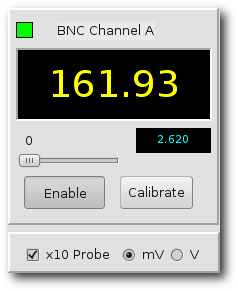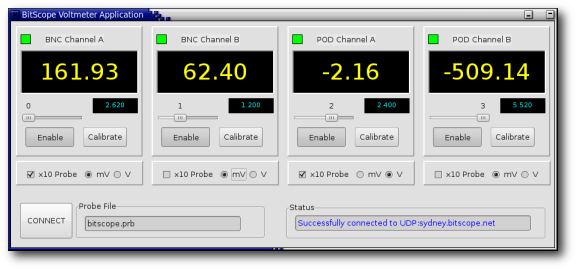

The BitLib Meter application is a program built with BitLib that implements a useful multi-channel voltmeter. It demonstrates how to use all analog inputs at once (2 x BNC + 2 x POD) as well as the calibration features of the library.

The screenshot above shows what the meter looks like when connected to the Sydney BitScope.
If connected to the Internet you should be able to use BitLib Meter to do the same.
All BS3xx model BitScopes including Sydney have 4 analog inputs; two BNC and two on the POD.
The meter application makes use of them all. In fact, when connected to BS442N there are eight concurrent voltmeters created by this application.
Of course the waveforms connected to Sydney are AC so the readings provided by the meter in this case will usually show a value close to zero (ie, the DC bias).
As with all BitLib applications, the library takes care of connecting with the BitScope (even half way around the world as this example shows).
Source code is included so you can modify it yourself (eg, perhaps you can add AC measurement). For an even more comprehensive voltage (and frequency) meter check out the BitScope WaveMeter.
The BitLib Meter allows the analog input range for each channel to be independently selected.
In effect this sets the sensitivity of the voltmeter to allow even very small voltages to be measured.
To change the range simply move slider below the display.
If using a x10 attenuating probe you can select this too allowing high impedance voltage measurements to be made and the display can be switched to report volts or millivolts.
Each channel may also be calibrated to eliminate any small offsets either in the circuit under test or in BitScope itself. Simply connect the probe to a zero volt DC reference (ie, the circuit ground) and click the Calibrate button while the channel is enabled.
This "zeros out" any DC offset that is present allowing subsequent measurements to be made more precisely. Note that the calibration offset applied is recored for each range on each channel. If you change the range you may to recalibrate the channel.
For more about offset calibration see the BitScope DSO channel calibration guide.